
Hollins Mill stood on Hollins Ln, Marple, and for some 124 years it was a major employer in the township of Marple. It was built around 1830 by Charles Walmsley for his son on part of an estate, which he had purchased in 1826 from Caleb Heginbotham. This estate stretched from Hollins Ln to the Peak Forest Canal and from New Rd to what is now Station Rd. As well as the mill, Charles Walmsley also built Hollins House off the south side of Station Rd, now Marple Memorial Park.
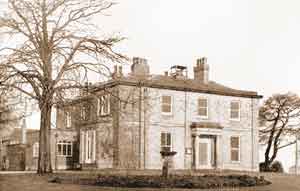
Hollins House.
In 1836, the Hollins Mill Private Branch was cut from between locks 12 and 13 of the Marple flight and it had two bridges. The first was the towpath bridge over the entrance and the second was adjacent to the mill, which carried the drive to Hollins House over the branch. This branch was principally used for the receipt of raw cotton to be manufactured into cloth and slack to fire the mill boilers and for the delivery of finished cloth. Slack was a mixture of small pieces of coal, coal dust and dirt. By way of example, over the period 16 Feb 1926 to 6 Jun 1935 there were 502 deliveries of cotton, comprised of 498 from the Rochdale Canal in Manchester, two from Ancoats, one from Fairfield and one from WCW(?). Originally, the cotton would have come into Manchester Docks via the Manchester Ship Canal. The total quantity of cotton received over this period was around 5,648 tons, based on an average boatload of 11¼ tons. Likewise, over the period 18 Mar 1926 to 6 Jun 1935 there were 771 deliveries of slack. The total quantity of slack delivered over this period was around 17,733 tons based on an average boatload of 23 tons. Without exception, the slack came along the Macclesfield Canal from Hall Green, which meant that its source was the North Staffordshire Coalfield centred on Stoke-on-Trent and Newcastle-under-Lyme. Correspondingly, over the period 2 Feb 1926 to 6 Jun 1935 there were 542 deliveries of finished cloth to Manchester The total quantity of cloth delivered over this period was 4,318 tons, which meant that the average boatload was about 8 tons.
In 1857, the mill was advertised as being available for lease but instead it was sold to four business partners, twin brothers Thomas and John Carver and brothers Samuel and Edwin Hodgkinson.
Thomas and John Carver were able to do this with the assistance of a loan of £15,000 from their father, William Carver, who wanted the family to diversify from their carrying business. The twins were born in Manchester in 1832 and they were baptised at Manchester Cathedral on the 7 Feb 1832.
Both Samuel and Edwin Hodgkinson had prior experience in textiles and for the first six years of the partnership the business was known as S Hodgkinson & Company. After a while the Hodgkinsons dropped out of the business and the Carver family continued to operate it as the Hollins Mill Company with an office on Moseley St and later on Portland St, Manchester. By the early 20th century, Hollins Mill was specialising in the manufacture of 'quality goods' and, in particular, the sheets it produced were sold to businesses and organisations such as the Cunard and White Star Shipping Lines, the Canadian Pacific Railway Company and the Salvation Army. In time, these sheets came to be known as 'Marple Sheets'.
After World War II the Carver family joined the William Thompson Combine, which in turn was taken over by Tootal Broadhurst Lee. It was the latter company who finally closed the mill in 1954.
Hollins Mill did both the spinning and weaving of cotton, which was in contrast to many mills that specialised in one or the other but not both. The spinning section was housed in a five-storey mill, while the weaving sheds were adjacent to it.
Thomas Carver JP moved into Hollins House but his brother, John, was a 'sleeping partner' in the business. For example, in 1861 he was resident at Stretford where he described himself as a Yarn & Cloth Agent & Cotton Spinner and in 1881 he was resident at Brighton where he described himself as a Cotton Manufacturer.
Samuel Hodgkinson was born in Chorley, Lancashire, in 1823/24, and in 1881 he was resident on Cross Ln, Marple, where he described himself as a Cotton Spinner Manufacturer. Cross Ln is off Stockport Rd, a short distance away from the mill.
Over the years, Thomas Carver and his family followed in the footsteps of Samuel Oldknow to become benefactors of Marple. The family either provide or assisted with the building of places of worship, a working men's club, a coffee house, a library and a boys' club and gymnasium (now the Carver Theatre) and a cinema. Additionally, Walter Bright Hodgkinson JP, son of Samuel Hodgkinson, born in Chorlton, Manchester in 1856, gave the land on which Marple Recreation Ground now stands, the laying out of the ground being paid for by the Carver family. To commemorate the opening of the recreation ground on the 8 Oct 1910, a medallion was struck, which was given to Marple children.
The Carver family moved away from Marple in c.1920 after giving Hollins House and surrounding land to Marple Urban District Council. The house became the Council Offices and in 1922 the land was converted into the War Memorial Park.
In 1953, 12 months prior to its official closure as a mill, Kay Brothers Ltd, Chemists and Druggists, moved into it. In 1959, a company called Kay Brothers Plastics Ltd was established there to manufacture plastics developed by the Beyer Organisation of Western Germany. In 1960, the Reckitt Colman Group acquired both Kay Brothers Ltd and Kay Brothers Plastics Ltd and in 1963 the business was moved to Bollington.
In 1957 the spinning mill was demolished and in October of the same year the mill chimney was blown up the well-known demolition expert Blaster Bates (aka Derek McIntosh Bates, 1923-2006). The weaving sheds survived until 1988 when they too were demolished to make way for a Co-op Superstore. The derelict Hollins Mill Private Branch was filled in during the 1950s.
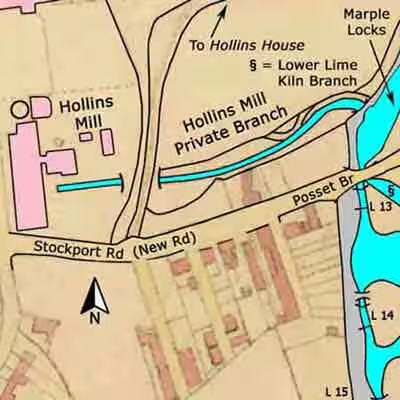
Hollins Mill Private Branch
Peak Forest Canal
Grid Ref: SJ 959 886
Tithe Map: 1850, Ref: EDT 262/2
Courtesy: Cheshire Archives & Local Studies
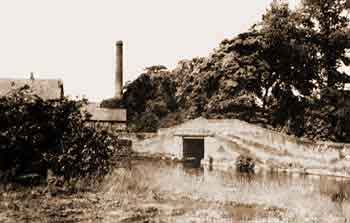
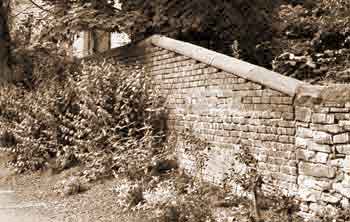
The towpath bridge over the entrance to Hollins Mill Private Branch, 1950s.
The entrance is seen from the site of Black Wharf, between locks 12 and 13. The chimney in the background belongs to Hollins Mill.
The rear wall of the towpath bridge over Hollins Mill Private Branch, Jul 2007.
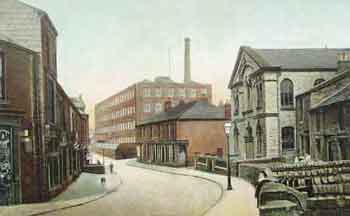
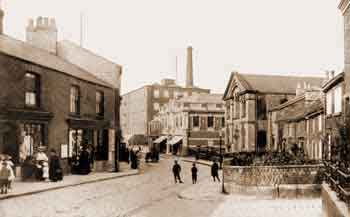
Hollins Mill, Hollins Ln, 1900.
View looking across New Rd (now Stockport Rd) from Market St.
The chapel on the right is the Trinity Primitive Methodist Chapel on Market St and beyond, in the terraced row, is the Marple branch of the Compstall Industrial Co-operative Society.
Hollins Mill, Hollins Ln, c.1906.
View looking across New Rd (now Stockport Rd) from Market St showing the new Marple branch of the Compstall Industrial Co-operative Society.
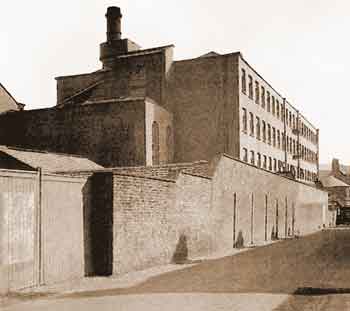
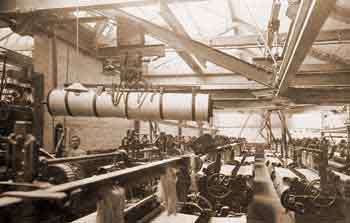
Hollins Mill, early 20th century.
View looking along Hollins Ln towards New Rd (now Stockport Rd).
Inside a weaving shed of Hollins Mill, 1914.
The workman is lowering a beam of cotton into place at the rear of a loom. The cotton threads on a beam are used to form the warp of woven cloth.